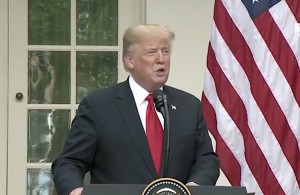
Prices on new cars may jump 25% after the first of the year due to the new tariffs on China by the Trump administration.
President Donald Trump must be out of eyes by now. His ongoing, eye-for-an-eye style trade tariff war continues, and will raise prices on Chinese goods another 10% starting next week, fanning fears about the prices of new vehicles and parts.
The Trump administration levied the new 10% tariff on $200 billion worth of Chinese goods on Monday night. They take effect on Sept. 24, and are set to jump to 25% on Jan. 1. To keep pace, of of course, China retaliated with $60 billion worth of new tariffs of its own.
As usual automakers have decried the new tariffs, complaining the new levies impinge their ability to import or export vehicles as well as the parts for repairs. Thus far, Trump has turned a deaf ear to the complaints.
“Applying an additional $200 billion in tariffs on China’s exports to the United States will further harm the U.S. auto industry and American workers and consumers,” John Bozzella, CEO of the Association of Global Automakers, which lobbies for foreign-owned car manufacturers, said in a statement.
(Trump puts Ford in Twitter crosshairs about China-built Focus. Click Here for the story.)
Products affected by the new tariffs announced by the Trump administration include “gaskets, washers and other seals, of noncellular vulcanized rubber other than hard rubber, for use in automotive goods” and “wastes of metal-pickling liquors, hydraulic fluids, brake fluids and anti‐freeze fluids.”
The new round of U.S. levies also includes “transmission shafts and cranks other than camshafts and crankshafts,” according to the Detroit News, which listed several other materials and components as well.
Trump continues to defend the tariffs, saying the $375 billion trade deficit with China is ridiculous and the U.S. acts as “the piggy bank to the world. We’ve been ripped off by China, we’ve been ripped off by … the European Union … we’ve been ripped off by everybody. I want to protect the American worker, the American farmer, the ranchers, the companies.”
China’s Finance Ministry said its tariff increases are aimed at curbing “trade friction” and the “unilateralism and protectionism of the United States.”
The two sides have already imposed import taxes on $50 billion worth of each other’s goods thus far, with Trump threatening to add an additional $267 billion in Chinese imports to the target list if China retaliated for the latest U.S. taxes.
(Click Here for more about Trump tariffs.)
That would raise the total affected by U.S. penalties to $517 billion, covering nearly everything China sells to the United States.
Car buyers will likely start feeling the pinch at U.S. dealerships soon, especially if the tariffs increase to 25% next year as scheduled. There are indications that car buyers are accelerating their purchase decisions to avoid this problem.
The cascading effect is that used car prices will also rise as new car buyers, feeling priced out of the market search for quality, highly contented vehicles. In short, nothing good will come of this for the auto industry, experts predict.s
“It’s hard to read a silver lining into this,” said Kristin Dziczek, vice president of the Industry, Labor & Economics Group at the Center for Automotive Research in Ann Arbor. “Tariffs are taxes on American consumers. We’re going to sell fewer. And not only do we buy car parts from the rest of the world, we sell parts to the rest of the world, especially Canada. It’s all going to cost more. These are not things producers can choose to not pass along. This hits profits. This means less reinvestment. It starts a downward cycle that isn’t good.”
Worse yet, China has the upper hand in this eye-for-eye battle, she told the Detroit Free Press.
(To see more about Trump’s auto tariff threat triggering backlash, Click Here.)
“China can wait us out. They have thousands of years of patience. For the car industry, this means a lot of efficiency they’ve gained from building up the global supply chain is lost. It’s not easy to resource these things. The thing is, you can make it more difficult to get parts from China, and automakers and suppliers will not necessarily bring that work back to the United States. There are lots of other places in the world that make those parts. Hitting only China doesn’t solve the problem or bring work back to the United States.”

